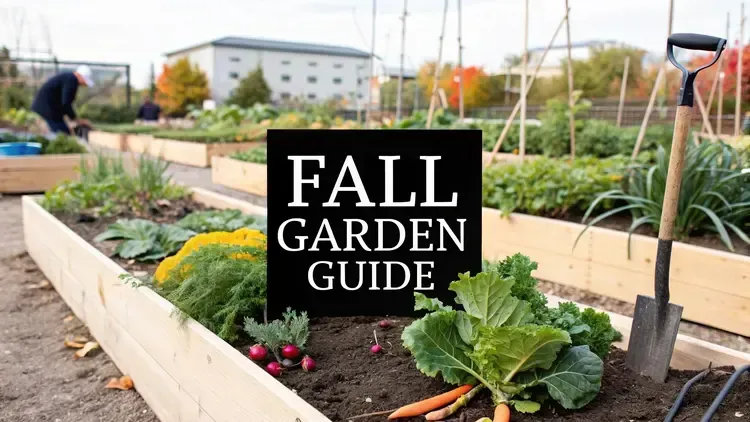
What to Plant in Fall Garden: Top 7 Crops for 2025
What to Plant in Fall Garden: Top 7 Crops for 2025
What to Plant in Fall Garden: Top 7 Crops for 2025
7 Fall Garden Planting Comparison
As summer's heat begins to fade, many gardeners hang up their trowels, but the savvy ones know a second, often more rewarding, season is just beginning. A fall garden is not merely an extension of summer; it is a unique opportunity to cultivate crops that thrive in cool weather, developing richer, sweeter flavors than their summer-grown counterparts. This shift also means contending with fewer pests and less watering, making for a more relaxed gardening experience.

This guide provides a definitive roadmap for what to plant in your fall garden, moving beyond simple suggestions to offer actionable strategies for seven exceptional cool-season crops. You will learn the ideal planting windows, specific soil preparation techniques, and recommended varieties for everything from crisp lettuces to robust kale and pungent garlic. Forget the disappointment of a garden gone dormant after August. By following these clear, targeted steps, you can ensure your beds remain productive and your kitchen is stocked with fresh, homegrown produce well into the colder months. Let's transform your plot into a year-round source of delicious, healthy food.

1. Kale
When considering what to plant in a fall garden, kale is often at the top of the list for good reason. As a member of the brassica family, this nutrient-dense leafy green is one of the most cold-hardy vegetables available. Unlike many summer crops that wither at the first sign of a chill, kale thrives in cool weather. In fact, its flavor and texture improve significantly after exposure to a light frost, as the cold prompts the plant to convert starches into sugars, resulting in a sweeter, more tender leaf.
This remarkable resilience makes kale a reliable producer throughout the fall and, in many climates, well into the winter. Gardeners in colder regions have developed simple techniques to keep the harvest going. For instance, community gardens in Vermont often harvest kale through December under a blanket of snow, while urban rooftop gardeners in Chicago can extend their kale season until February using cold frames.
Extending Your Harvest
The key to a long and productive kale season is proper timing and protection.
Planting Window: Sow seeds directly in the garden or start transplants 6-8 weeks before your area's average first frost date. This gives the plants enough time to establish a strong root system before the deep cold sets in.
Harvesting Method: To ensure continuous production, harvest the outer, lower leaves first. Snip them off at the base, leaving the central growing point and the smaller inner leaves intact. This "cut-and-come-again" method encourages the plant to keep producing new foliage from its center.
Season Extension: While kale is tough, using simple row covers or a cold frame can protect it from harsh winds and extreme temperatures, extending your harvest by weeks or even months.
If you’re looking for an easy way to keep your fall crops thriving through frost, a lightweight floating row cover like this one is one of the most versatile tools you can keep on hand.
For a quick reference, here are the key takeaways on why kale is an excellent fall crop.
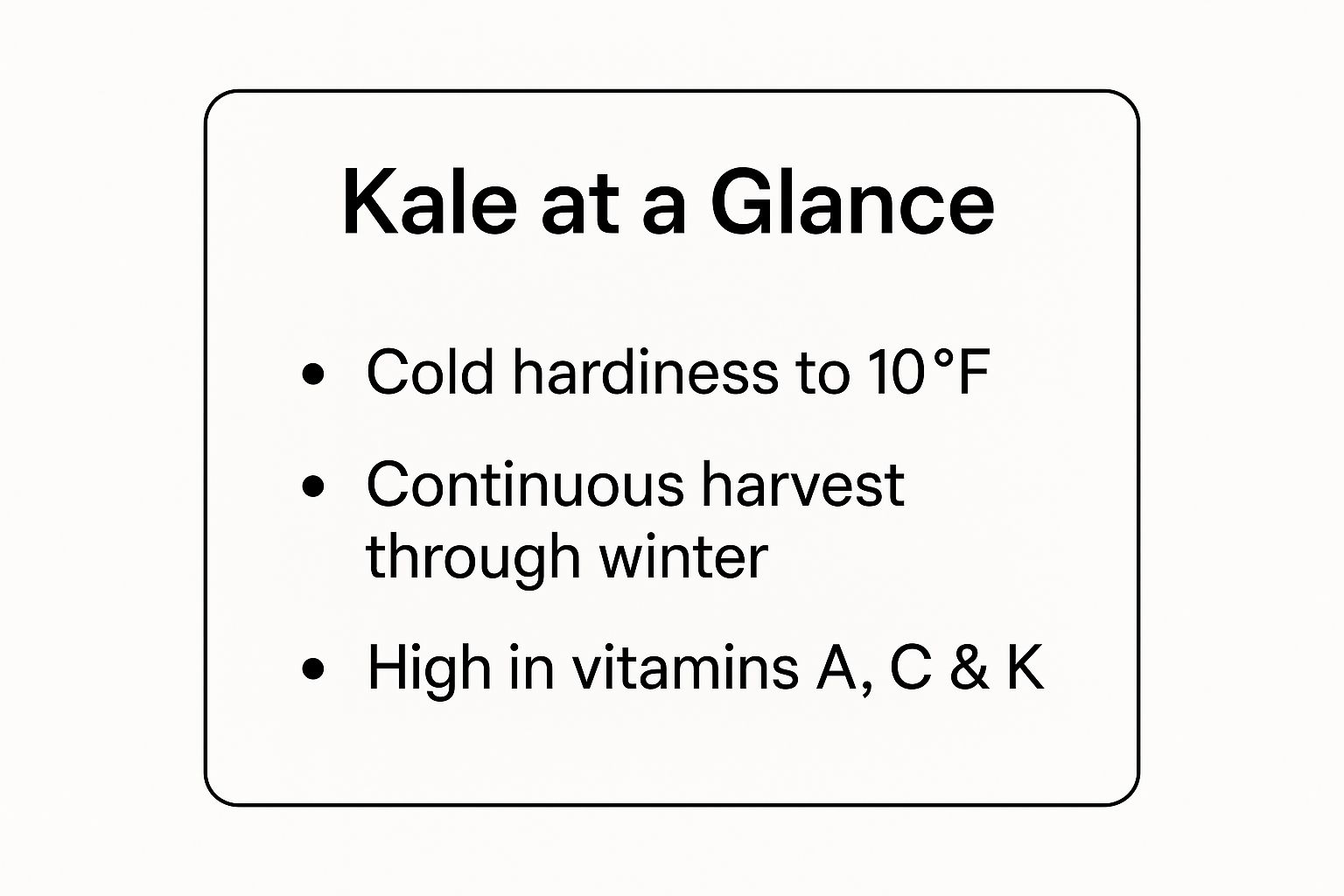
The combination of extreme cold hardiness and a continuous harvest window makes kale a standout choice for fall gardens. For maximum cold tolerance, look for varieties specifically bred for overwintering, such as ‘Winterbor’ or ‘Blue Curled Scotch’. To dive deeper into cultivating this superfood, you can find a wealth of beginner kale growing tips on The Grounded Homestead.
2. Spinach
When deciding what to plant in a fall garden, spinach is a quintessential choice for its rapid growth and love for cool weather. This nutrient-rich leafy green flourishes in the shorter days and moderate temperatures of autumn, a stark contrast to the challenges of spring planting when it's prone to bolt (flower prematurely). The cool air sweetens its leaves, providing a much richer flavor than spring or summer-grown spinach.
This preference for cooler conditions makes spinach a reliable and rewarding fall crop. Gardeners in North Carolina often enjoy fresh harvests well into January with minimal protection, while commercial farmers in Oregon utilize simple hoop houses to grow spinach straight through the winter. Even in colder climates like Canada, greenhouse operations can maintain year-round production, highlighting its adaptability.
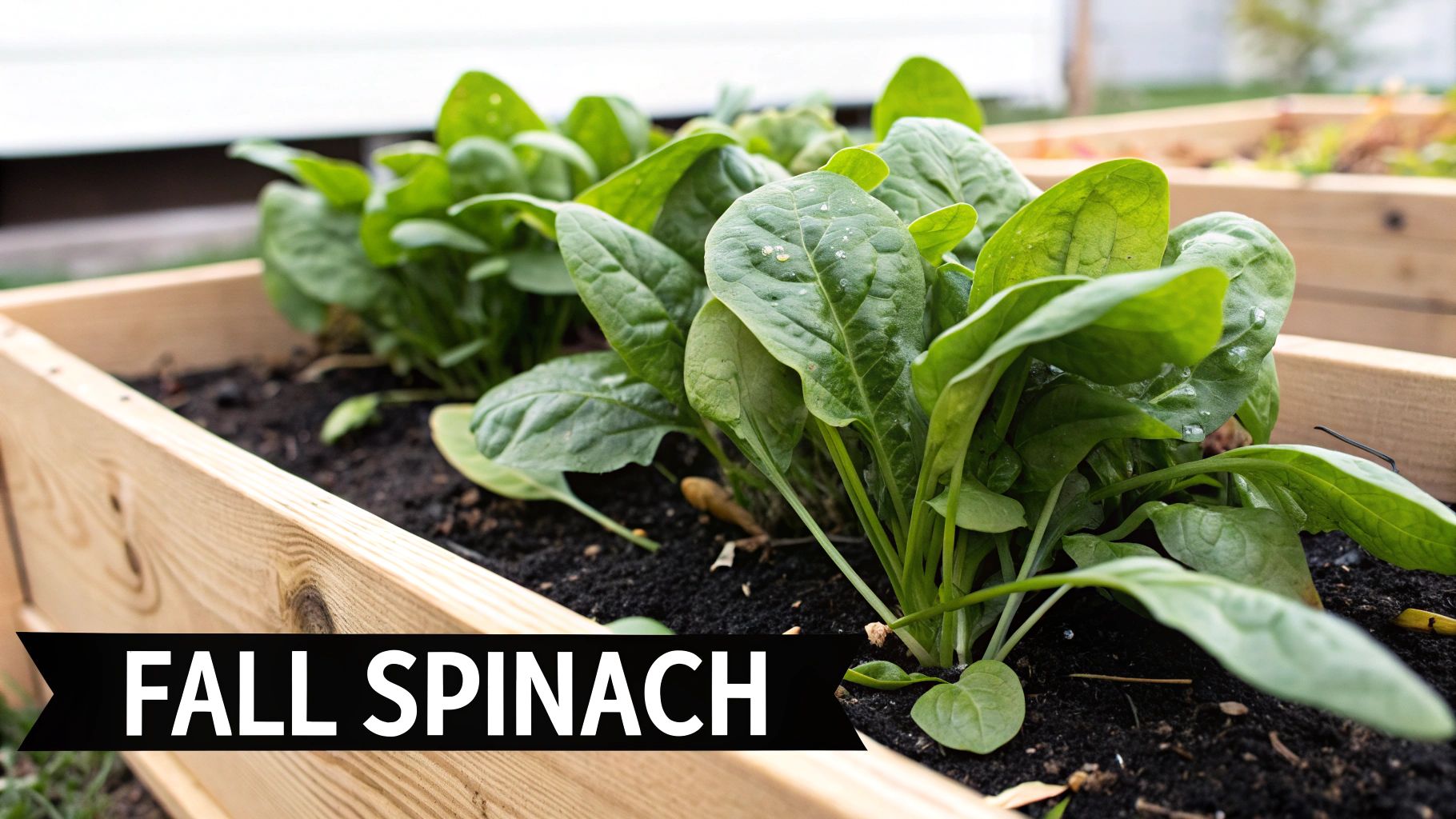
Extending Your Harvest
Achieving a long and bountiful spinach harvest hinges on successive planting and proper soil management.
Planting Window: Begin sowing seeds directly into the garden 4-6 weeks before the first expected frost. For a continuous supply, practice succession planting by sowing a new batch every two weeks until the first hard freeze.
Harvesting Method: You can harvest spinach in two ways. Either pick the outer leaves individually, allowing the inner leaves to continue growing, or cut the entire plant about an inch above the soil line. Many varieties will regrow for a second harvest if the central growing point is left intact.
Season Extension: Spinach is quite cold-hardy but will benefit from protection. A simple layer of mulch can protect the roots from freezing, while a cold frame or low tunnel can keep the harvest going for several more months, even in snowy conditions.
Want to push your harvest into winter? A compact cold frame like this kit creates a microclimate that protects leafy greens and encourages steady growth even when temperatures dip.
For a quick reference, here are the key takeaways on why spinach is an excellent fall crop.
The plant's fast maturity and aversion to bolting in cool weather make it a dependable and delicious addition to any fall garden. For best results, select slow-bolt varieties like ‘Tyee’ or ‘Bloomsdale Long Standing’. You can explore more detailed guidance on growing different spinach types in Savvy Gardening’s guide to spinach varieties.

3. Garlic
When you’re deciding what to plant in a fall garden, garlic is a unique and rewarding long-term investment. Unlike leafy greens that offer a quick harvest, garlic is planted in the autumn to be harvested the following summer. This extended timeline is crucial because garlic requires a cold period, known as vernalization, to trigger the development of its signature segmented bulb. Planting in the fall ensures the cloves experience the necessary winter chill, making it an essential practice in most growing zones.
The crop’s low-maintenance nature and high-value return have made it a favorite for both home gardeners and commercial growers. For instance, farms across New York specialize in robust hardneck garlic varieties that thrive in cold winters, while California's milder climate allows it to produce nearly 90% of the United States' commercial softneck garlic. Even small-scale farmers in places like Vermont have built entire businesses around specialty and heirloom garlic varieties, demonstrating its versatility and appeal.
Extending Your Harvest
The key to a successful garlic crop is proper planting technique and choosing the right type for your climate.
Planting Window: Plant individual cloves in the fall, typically 4-6 weeks before the ground freezes solid. This gives them enough time to develop roots but not so much time that they produce significant top growth that could be damaged by winter cold.
Planting Method: To ensure proper bulb formation, plant each clove with the pointed end facing up, about 2 inches deep and 4-6 inches apart. After planting, apply a thick layer of mulch (straw, shredded leaves, or grass clippings) to insulate the soil, suppress weeds, and retain moisture.
To give your root crops the best chance of growing straight and strong, using a broadfork like this one is a gentle, no-till way to aerate your soil without disturbing its structure.
Variety Selection: Choose your garlic type based on your climate. Hardneck varieties are more cold-hardy and produce a flowering stalk called a "scape," making them ideal for northern regions. Softneck varieties are better suited for warmer climates and are the type you typically find in supermarkets due to their excellent storage qualities. Always source your "seed garlic" from reputable suppliers like Filaree Garlic Farm or Keene Garlic, as grocery store garlic may be treated to prevent sprouting.
For a visual guide on the planting process, this video provides excellent step-by-step instructions.
The simple act of planting in the fall sets the stage for a bountiful harvest the next year, making garlic a standout crop for any forward-thinking gardener. For gardeners interested in preserving unique agricultural heritage, organizations like the Seed Savers Exchange offer a wide array of heirloom garlic varieties.

4. Radishes
For gardeners seeking quick satisfaction, radishes are an essential crop when deciding what to plant in a fall garden. These fast-growing root vegetables thrive in the cooler temperatures of autumn, often producing a harvest in as little as three to four weeks. Unlike their spring-sown counterparts, fall-grown radishes benefit from the progressively cooler soil, which results in larger, milder, and less pungent roots. Their rapid growth cycle makes them an ideal choice for filling gaps left by summer crops.
This speed and preference for cool weather make radishes a reliable and rewarding fall vegetable. Their versatility is seen in gardening traditions worldwide. For instance, Japanese gardeners cultivate massive daikon radishes in the fall, which can reach several feet in length. In Europe, varieties like the Black Spanish radish are grown specifically for their excellent storage qualities, lasting for months in a root cellar. Similarly, Korean farmers dedicate significant acreage to fall radish cultivation, as it's a primary ingredient for making kimchi for the winter.
Extending Your Harvest
The key to a successful and continuous radish crop lies in succession planting and timely harvesting.
Planting Window: Begin sowing seeds directly into the garden 4-6 weeks before the first expected frost. To ensure a steady supply, plant a new row every one to two weeks until about a month before your ground is expected to freeze solid.
Harvesting Method: Harvest radishes as soon as they reach their ideal size. Leaving them in the ground too long can cause them to become woody or crack. Check their progress by gently brushing away the soil at the base of the leaves. For storage varieties like daikon or black radishes, allow them to grow to full maturity but be sure to pull them before the ground freezes.
Thinning Seedlings: To allow the roots to develop properly, it is crucial to thin your radish seedlings. Once they are an inch or two tall, thin them to stand about 2-3 inches apart. Overcrowding prevents the roots from swelling and results in a poor harvest.
5. Brussels Sprouts
When deciding what to plant in a fall garden, Brussels sprouts are a top-tier choice for the patient gardener. As another member of the brassica family, these plants produce small, cabbage-like heads along a tall, sturdy stalk. Brussels sprouts are famous for their remarkable flavor transformation in cool weather; a touch of frost converts their starches to sugar, resulting in a nutty, sweet taste that is far superior to their store-bought counterparts.
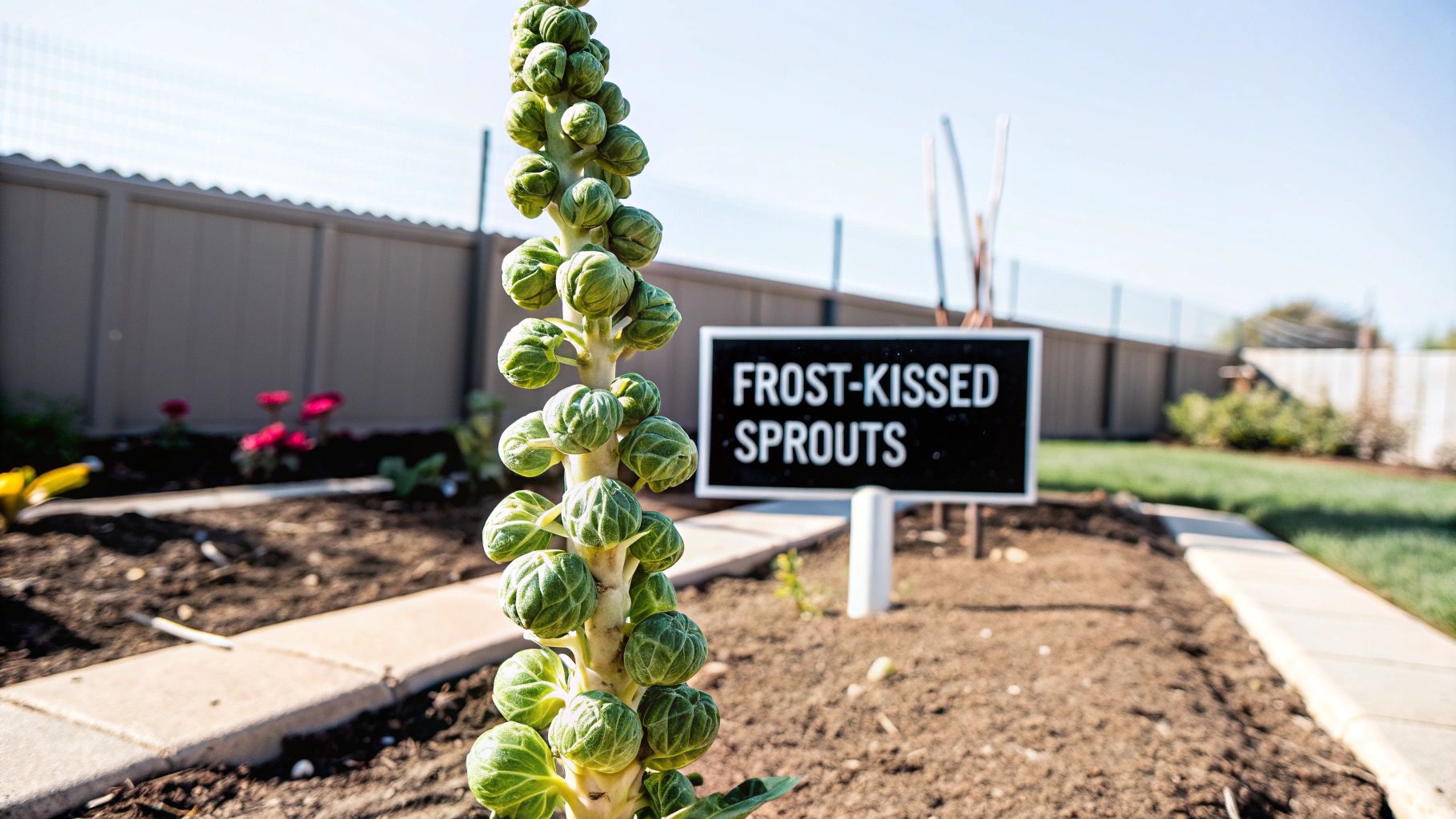
This long-season crop requires an early start but rewards gardeners with an abundant harvest deep into autumn and even early winter. For instance, home gardeners in Minnesota successfully cultivate robust crops by starting seeds indoors in late spring and using season extension techniques. Similarly, farmers in the Pacific Northwest leverage the region's mild, cool fall to grow Brussels sprouts as a specialty crop, prized for its post-frost sweetness.
Extending Your Harvest
Success with Brussels sprouts hinges on giving them a long growing season and harvesting them at their peak.
Planting Window: Brussels sprouts need a long time to mature, typically 90-110 days. For a fall harvest, start seeds indoors in late spring or early summer, and transplant seedlings into the garden about 12-14 weeks before the first expected frost. This timing ensures they mature during the cool days of autumn.
Harvesting Method: The sprouts mature from the bottom of the stalk upwards. Begin harvesting when the lower sprouts are firm, compact, and about 1-2 inches in diameter. Twist or snap them off the main stalk. To encourage the upper sprouts to develop, remove the yellowing leaves at the bottom of the plant as you harvest.
Season Extension: These plants are very cold-tolerant, but row covers or a thick layer of straw mulch can protect them from heavy snow or deep freezes, allowing you to continue harvesting well into the winter in many climates.
The payoff for their long growing season is a delicious, homegrown vegetable that simply can't be matched for flavor. Look for varieties like ‘Long Island Improved’ for a reliable, classic choice or ‘Jade Cross E’ for more uniform sprout production.
6. Carrots
When you're deciding what to plant in a fall garden, carrots are an essential choice for a sweet, rewarding harvest. This popular root vegetable undergoes a fantastic transformation in cool soil. As temperatures drop, carrots convert their starches into sugars, a natural antifreeze mechanism that results in a noticeably sweeter and crunchier root than those grown in the heat of summer. This makes fall the ideal season for growing the most flavorful carrots.
The ability of carrots to be stored directly in the ground is a significant advantage for fall gardeners. For example, home gardeners in Colorado can heavily mulch their carrot beds to insulate them from freezing, allowing them to pull fresh, crisp carrots from the ground well into the winter. Similarly, farmers in Quebec have long perfected the art of growing carrots for winter storage in root cellars, relying on the cool fall weather to produce a robust and long-lasting crop.
Extending Your Harvest
Achieving a successful fall and winter carrot crop comes down to proper soil preparation and timing.
Planting Window: Direct sow carrot seeds in the garden about 10-12 weeks before your average first frost date. Carrots are slow to germinate, so this provides ample time for the roots to mature to a harvestable size before the ground freezes solid.
Soil Preparation: Carrots require loose, well-draining, and rock-free soil to develop straight roots. Tilling or broadforking the bed to a depth of at least 12 inches is crucial. Consistent moisture is also vital, especially during the germination phase.
Thinning and Mulching: Once seedlings are a few inches tall, thin them to about 2-3 inches apart to give the roots room to expand. After the first couple of light frosts, apply a thick layer of mulch (6-12 inches) like straw or shredded leaves over the bed. This insulation will protect the roots from deep freezes and allow for an extended harvest.
The combination of improved flavor and in-ground storage makes carrots a fantastic and low-maintenance addition to any fall garden. For optimal sweetness and cold tolerance, choose varieties known for their storage capabilities, such as ‘Danvers’, ‘Nantes’, or ‘Chantenay’. For more in-depth guidance on getting the perfect crop, you can explore the extensive carrot growing resources available at The Old Farmer's Almanac.
7. Lettuce
When you think about what to plant in a fall garden, crisp, fresh lettuce should be a top contender. While often associated with spring salads, lettuce performs exceptionally well in the cool, stable conditions of autumn. Unlike the spring season, where a sudden heatwave can cause plants to bolt (flower prematurely), the gradually cooling temperatures of fall allow lettuce to mature slowly, developing a sweeter flavor and a wonderfully crisp texture without the bitterness that heat can bring.
This cool-season preference makes lettuce an ideal crop for extending the fresh-eating season. Gardeners can enjoy harvests well past the first light frosts, especially with the right techniques. For instance, commercial growers use unheated high tunnels or greenhouses for four-season harvesting, supplying farmers markets with fresh salad mixes deep into winter. Similarly, home gardeners can easily replicate this success on a smaller scale, ensuring a steady supply of homegrown greens when most other crops have finished.
Extending Your Harvest
The secret to a successful and long-lasting fall lettuce crop lies in variety selection, timing, and simple protection.
Planting Window: For head lettuce, start seeds indoors 4-6 weeks before your first frost date and transplant them out. For loose-leaf varieties and salad mixes, you can sow seeds directly into the garden every two weeks, starting in late summer, for a continuous harvest.
Harvesting Method: Employ the "cut-and-come-again" technique for loose-leaf types. Harvest only the outer, larger leaves, leaving the central crown to produce new growth. For head lettuce, you can harvest the entire head once it's firm and ready.
Season Extension: A simple floating row cover is your best tool for fall lettuce. It provides enough insulation to protect plants from frost without trapping excess heat, allowing you to harvest weeks longer than you could in an unprotected bed.
Variety Selection: Choose varieties known for their cold tolerance. Butterhead types like ‘North Pole’ and romaine varieties such as ‘Winter Density’ are specifically bred to withstand chilly temperatures and will give you the best late-season results.
The consistent, cool weather of fall provides the perfect environment for growing high-quality lettuce. If you encounter any challenges along the way, you can troubleshoot them by learning about common lettuce problems and fixes on The Grounded Homestead.
7 Fall Garden Planting Comparison

From Fall Planting to Winter Feasting
As the summer sun begins its gentle retreat, your garden’s story is far from over. This is not an ending but a new chapter, a transition into the cool, crisp season of autumn abundance. Throughout this guide, we've explored a curated list of resilient and rewarding crops, demonstrating that a thriving garden is a year-round possibility. Your journey into fall gardening starts now, armed with the knowledge of what to plant in a fall garden to ensure a continuous harvest.
The key to unlocking this potential lies in a few core principles we've discussed. From the quick satisfaction of spicy radishes to the patient cultivation of robust garlic that will overwinter for a summer prize, success is rooted in strategic timing and smart preparation. You now have a blueprint for action, understanding how to leverage your local frost dates, amend your soil for optimal health, and select specific, cold-hardy varieties of kale, spinach, and lettuce that don't just survive but flourish in cooler temperatures.
Your Action Plan for a Bountiful Autumn Harvest
The true value of a fall garden extends beyond the dinner plate; it’s about deepening your connection to the seasons and building a more resilient, self-sufficient homestead. The difference between a garden that fades with summer and one that thrives into winter is simply action.
Here are your immediate next steps:
Finalize Your Crop List: Revisit the seven featured crops. Decide which ones, like fast-growing spinach or steady carrots, best fit your climate, available space, and culinary preferences.
Source Your Seeds: Don't delay. Procure high-quality, cold-tolerant seeds for your chosen vegetables. Look for the specific varieties we recommended, such as 'Winterbor' kale or 'Bloomsdale Long Standing' spinach, for the best results.
Prepare Your Garden Beds: The time is now. Clear out spent summer plants, add a generous layer of rich compost, and ensure your soil is loose and ready to welcome new seeds and seedlings.
Gather Your Season-Extension Tools: Assess your need for simple tools like thick mulch, row covers, or cold frames. Having these on hand before the first frost is crucial for protecting your precious plants.
Mastering what to plant in a fall garden transforms you from a seasonal gardener into a year-round producer. It’s about the satisfaction of stepping outside on a chilly November day to harvest fresh greens for your meal. This practice builds skill, fosters a deeper understanding of nature’s cycles, and provides your family with nutrient-dense food long after the summer tomatoes are a fond memory. Embrace this opportunity to extend your growing season, and you will be rewarded with a pantry full of homegrown flavor and a profound sense of accomplishment.
Video Summaries of this issue:
As always, the tools and supplies I mention are the same ones I rely on here at The Grounded Homestead. Some are affiliate links, which means I may earn a small commission—at no extra cost to you—but every recommendation is based on real use and trust.
Ready to take your homesteading skills to the next level? At The Grounded Homestead, we provide in-depth resources, practical guides, and a community focused on sustainable, year-round gardening. Visit The Grounded Homestead to explore our courses and join our newsletter for exclusive tips that go beyond what to plant in a fall garden.

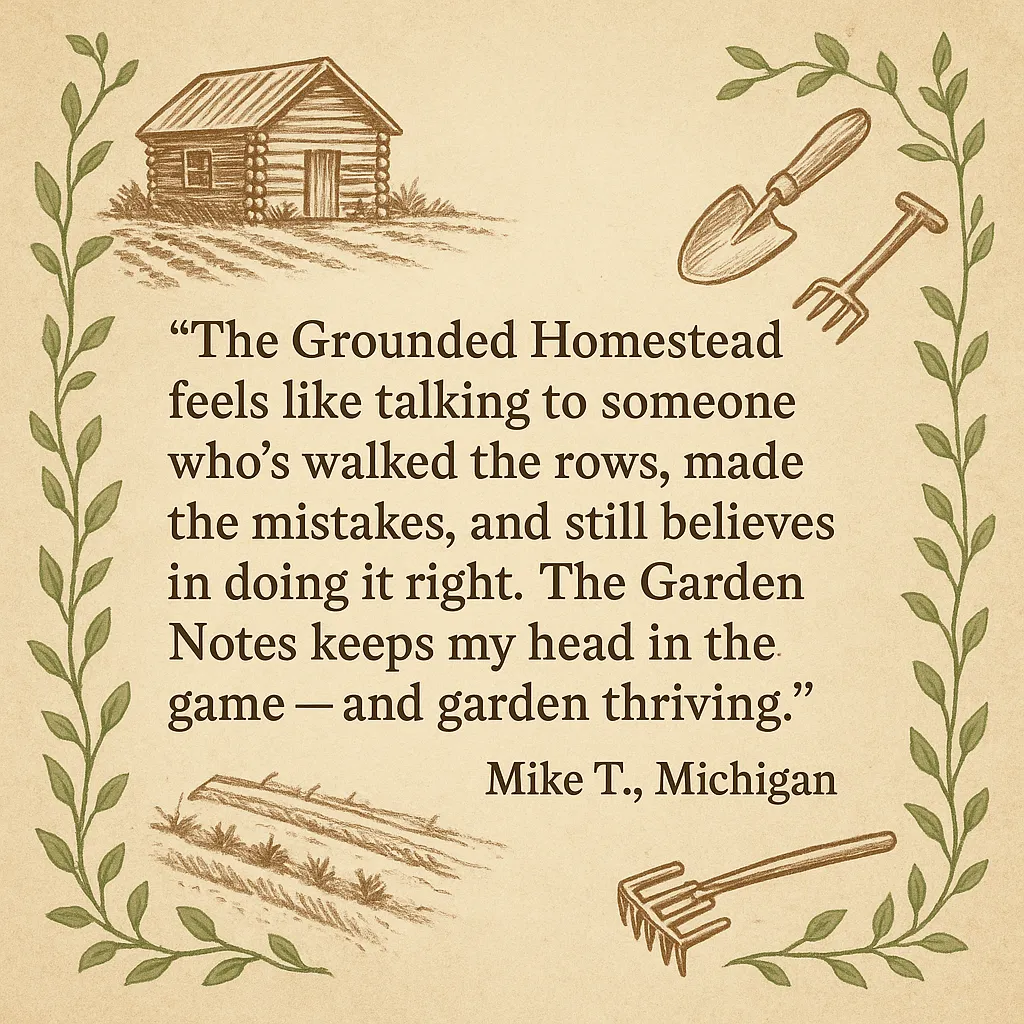
Facebook
Instagram
X
Youtube